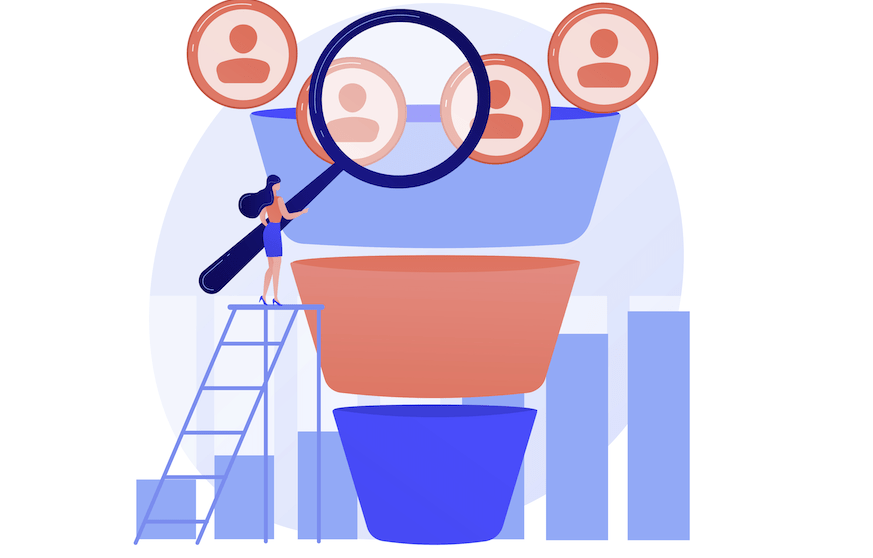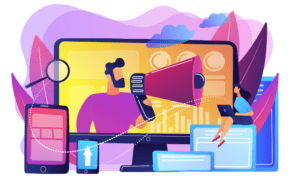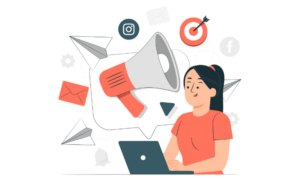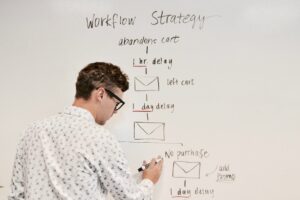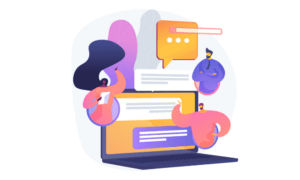Building a sales pipeline is like building the foundation for your house. Your house will not stand if you don’t build the foundation correctly. The same thing goes for your sales pipeline. Your company will not be able to compete if your pipeline is not well thought out and sturdy. Fortunately, we are going to go through how to build a strong sales pipeline for your B2B business. First, we are going to go through some pipeline basics to increase your understanding.
What is a Sales Pipeline?
A sales pipeline is a visual representation of how you are able to acquire leads, and guide them through the events that lead to the lead converting to a paying customer. By understanding your sales pipeline, you will be able to understand your leads and what they expect from your company. As a result, you’re more likely to convert prospects into paying customers.
Sales Funnel vs Sales Pipeline
Sales funnels and sales pipelines are often used interchangeably. But, they are not the same thing. A sales funnel is a more broad overview of how you acquire customers, including where they tend to drop off. On the other hand, a sales pipeline is broken down into more in-depth steps. Understanding both your sales funnel and sales pipeline can help you prospect more successfully, as well as lead them through your buyer’s journey and make the sale.
Understand the Sales Pipeline Stages
To get the most out of your sales pipeline strategy, you’ll need to have a thorough understanding of the steps that are involved. Keep in mind that after every step there will be a decrease in leads. This is because not every prospect will be qualified to purchase right now.
Stage 1: Prospecting
The first stage in your sales pipeline is prospecting. In this stage, you will be generating leads via cold calling, cold emailing, reaching out on LinkedIn, and other prospecting methods. The prospecting methods that you choose will be based on your specific product, goals, and budget. If you’re not sure what is the best prospecting method for your company, take a look at this list of the top B2B prospecting methods that almost any company can benefit from.
Stage 2: Qualifying Leads
Once you have prospected a number of potential leads, you’ll need to qualify them. Not every prospect will be a qualified lead. So, in this step you need to ensure all of the leads that you want to move forward would be interested in what you have to offer. As an example, you may reach out to a prospect on LinkedIn, and you know that their company is a perfect fit for your service, but they don’t have the budget for your service right now. Instead of trying to push them through your sales pipeline before they’re ready, add them to your CRM and follow up with them in a few months to see if they are ready then. If you push them through before they are ready, you may lose the client completely. Once you have qualified your prospects, you are ready for your initial meeting.
Stage 3: Initial Meeting
Once you have qualified your prospect and have communicated with them to ensure they’re interested, you’re ready to schedule an initial meeting. This meeting will look different for every company and will also look different for every lead that you meet with. You must personalize each meeting based on your prospect’s needs, wants, and the value that you will bring to the table. During your initial meeting, you can discuss use cases, case studies, provide a personalized demo, and start to build a relationship with your prospect.
Stage 4: Define Prospect Needs
Although this is technically the fourth stage in building your sales pipeline, you should always keep your prospect’s needs in mind. I find this concept can be used throughout every stage. Especially when you are qualifying leads and during your initial meeting. You always want to have what your prospect needs at the forefront of your mind, as it will help you deliver your sales pitch. In addition, every prospect that you have may have different needs and might be looking for a slightly different solution. You’ll also want to provide information about how your product or service will benefit them relatively early on in your discussions. This is because it can make or break your client giving you their time for the initial meeting.
Stage 5: Make an Offer
The next stage is to make your prospect an offer. It could take just one sales call, or it could take several sales calls to get to this point. Your offer could include exclusive features that will entice the prospect and show them what they would miss out on if they said no. But, as a salesperson, getting a “no” is not always a bad thing. So, try not to get discouraged in the process. Often clients will have a lot of questions and hesitations at this point. This is why it’s so important to have a thorough understanding of your product and how it will benefit your prospect.
Stage 6: Negotiation and Finalize Proposal
After you make an offer, the prospect may accept right away. Or, it could take some back and forth to come up with a plan that you are both happy with. Typically the more expensive the product or service is, the longer the negotiation will take. Negotiations will look different for every company. But, after a few deals you will have a good understanding of what your typical negotiation looks like.
Stage 7: Closing the Deal
Once the prospect has agreed to all terms and conditions and is familiar with your product, you’re ready to close the deal. In this stage, payment will be made and onboarding will begin. Ensure that you are there to answer any calls or emails from them, as this is a vital part of properly building a relationship with your new client. If you go days without answering their question, there is a good chance that they will not repurchase.
Stage 8: Deliver the Product or Service
Congratulations you’ve made it to the final stage in your sales pipeline! In this stage, you are providing your product or service to your new client. I often see companies simply delivering their product, and stopping there. But, you need to continue to support them for the entire time they are using your product or service. Whether it be by onboarding new clients, engaging with them on LinkedIn, asking for feedback, providing other learning resources, a live chat for any questions, or other ways to keep in touch with your new clients. By continuously providing them with a positive experience, you are able to retain clients for a much longer time period. And, it will ultimately result in more revenue for your company.
Add More Leads to Your Funnel
One of the most common questions I hear in regards to building a sales funnel is how to add more leads to the funnel. This is often a tricky step for B2B companies and can be very discouraging. Fortunately, Visitor Queue can help you generate high-quality leads that are ready to convert. Visitor Queue is a B2B lead generation software that can identify the companies that visit your website, along with company information like a direct link to their website, history, and industry to help you qualify them. We also provide their visit information like how they were acquired, the pages they viewed, and how long they spent on each page. Additionally, we can identify employee contact information like email addresses, phone numbers, and LinkedIn sites to help you reach out. Send your new leads directly to your CRM and follow up. Lead generation and prospecting has never been so easy. Start your free trial of Visitor Queue today and stop losing leads.

Use Your CRM
When you are building your sales pipeline strategy, a CRM software is a huge asset to help you manage your new leads. From start to finish, your CRM will be your right-hand (wo)man. Depending on the software that you choose, it can assist you in generating leads, storing their contact information, automatically sending them the initial email, following up, and even onboarding them after they have committed. With the help of a CRM, you won’t need to set reminders of when to follow up with who.
Perform a Competitive Analysis
A competitive analysis is a fantastic way to compare your sales pipeline to others and optimize yours. Examining each of your competitors and how they position themselves will allow you to see if they are doing anything that you think your company would benefit from. Check out their reviews, the social media ads they are running, software that they are using, and other aspects of their company. If you’ve never performed a competitor analysis, here is a guide that will walk you through how to get the inside scoop on your competitors.
Optimize and Adapt
Your sales pipeline can and will change throughout the years. It’s a good thing that your funnel doesn’t stay the same. Just like any other sales or marketing concept, you need to adapt to include new technologies, emerging competitors, changes in employees, and other considerations. If you try to stick to the same model year after year, your revenue will eventually plateau and then start to decrease. This is because your competitors will adapt and optimize their pipeline, while you’re stuck doing tasks that are outdated. It’s best to change slowly over the years instead of having huge changes all at once as that can be confusing for both your employees and your prospects.
Final Words
Building a strong sales pipeline is essential for any B2B company. Without one, your sales strategies will start to crumble under the pressure. Once you build a sales pipeline, you will be able to manage your employees better and increase your conversion rate among leads. If you don’t know where to start, I would recommend sitting down with your team and brainstorming how their daily tasks fit into the model that is shown above. From there, you can see if there is any overlap between stages and optimize tasks. If you have any questions about how Visitor Queue can help you generate more leads, don’t hesitate to reach out.
 Identify
Identify Personalize
Personalize Benchmark
Benchmark Agencies
Agencies Integrations
Integrations Case Studies
Case Studies Use Cases
Use Cases Blog
Blog Resources
Resources